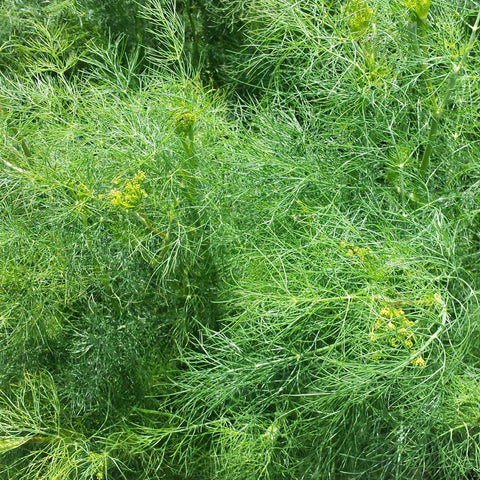

Hortinova
BUSHY - Open Pollinated Dill Seeds
Anethum graveolens
- Early variety (30-40 days)
- Compact bushy growth.
- Suitable for growing in pots or containers.
- Can be sown every 10-15 days throughout the summer.
- Use fresh, dried and for pickling.
Sow seeds directly in the soil as it does not transplant well. Choose a sunny location with well-draining soil. Sow the seeds in early spring after the last frost date for your region. Scatter the seeds on the soil surface, spacing them about 12-18 inches apart. The soil temperature should be between 60° and 70ºF (15° and 21°C) for the best germination results. Lightly cover the seeds with a thin layer of soil, as dill seeds need light to germinate. Keep the soil consistently moist during germination, which typically takes 7 to 14 days. To ensure a season-long fresh supply of dill, continue sowing seeds every few weeks. For an extended harvest of the leaves.
THIN: When the seedlings have grown to a few inches tall, thin them to a final spacing of about 10-12 inches apart. This ensures adequate airflow and prevents competition among plants.
WATER: Once the plants are established, water them regularly, especially during dry spells. Avoid overwatering, as dill prefers slightly dry conditions.
FEED: Dill thrives in moderately rich soil with a pH level between 5.5 and 6.5. Incorporate organic matter like compost into the soil before planting. Fertilize sparingly, as excessive nitrogen can reduce the aromatic quality of the leaves. A balanced fertilizer applied once during the growing season should be sufficient.
PROTECT: Apply a layer of organic mulch around the dill plants to conserve soil moisture, suppress weed growth, and maintain a stable temperature.
PRUNE: To encourage bushier growth, pinch off the flower buds as they appear. This will also prolong the plant's leaf production. If you are growing dill primarily for the seeds, allow a few plants to flower and produce seeds for harvesting.
Dill leaves can be harvested once the plant reaches about 8 inches in height. Snip off the leaves close to the stem but be sure not to remove more than one-third of the plant at a time to allow it to continue growing.
To harvesting seeds, wait until the dill flowers have dried and turned brown. Cut the flower heads and place them upside down in a paper bag. Shake the bag gently to release the seeds, which will be collected at the bottom.
Fresh dill leaves can be used immediately, while dried leaves can be stored in an airtight container in a cool, dark place. Dill seeds can be stored in airtight containers in a dry and cool place for several months.
Let customers speak for us
from 23 reviewsWe grow several varieties of various colours of tomatoes, and the contrast of these tomatoes with other colours is fantastic. We've had a very long season with our plants, excellent disease resistance, great flavour.

This review applies to all of the seeds I purchased from Hortinova - beautiful tomatoes, good disease resistance and excellent production. Our field season extended to 10 weeks. We've had comments of excellent flavour from our customers as well, highly recommend any Hortinova seed.

This tomato is good taste tomato. Small red round tomato. Bigger then cherry tomatoes but smaller then regular one. I like it. Perfect for salads and fresh eating. Ordered seeds for next season.

2nd time ordering. Very satisfied with qualify and result. Thank you

BALCONY YELLOW F1 - Hybrid Cherry Tomato Seeds

Delivered very fast, packed very good, in professional condition and quality. Thanks

DUETT - Open Pollinated Radish Seeds

We will see what they are like this summer.

Type crimson de bonne grosseur avec une superbe uniformité et très hâtif. Un des premiers prêt en saison. Semences très petites et peu nombreuses. Goût très sucré et chaire croquante. Chair passant du rose au rouge en cours de saison. Les plants sont forts et très vigoureux avec des grosses feuilles.

Vigueur des plants impressionante avec des fruits résistants aux fissures et aux dommages. Très bonne conservartion et goût très sucré lorsque les nervures deviennent orange. Peu être récolté lorsque les nervures sont vertes également. Cavité des semences très compacte et petite laissant beaucoup de chair.

Melon qui fond en boûche avec un goût se rapprochant du melon miel et du cantaloup à la fois, très sucré. Faire attention aux irriguations lorsque le melon devient mature car il peut fendre au champs. Très odorant.

Avec son apparence côtellée, son très gros calibre et ça couleur rose, cette tomate se démarque des autres sur les tablettes. Variété plus résistante à la pourriture apicale que la plus part des autres tomates roses. Bon ensemble de résitance aux maladies également.

Tomate noire dont les faces qui ne sont pas exposé au soleil passent du vert au rouge lorsque mature donnant un aspect unique aux fruits. Charactéristiques similaires à la Barrio avec un goût superbe sans acide. Les clients l'on adoré.

Superbe adaptabilité et excellente résistance aux maladies. Fruits uniformes qui ne fendent pas, bonne conservation. Ajoutez à cela un goût unique avec une légère acidité et une pointe sucré.















